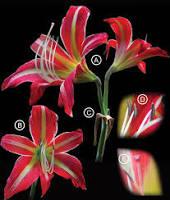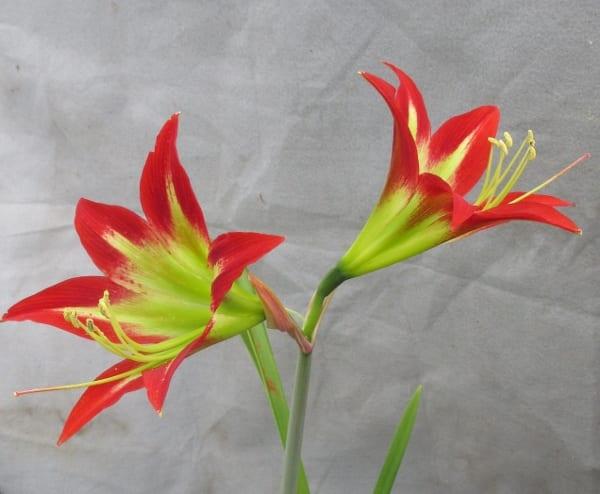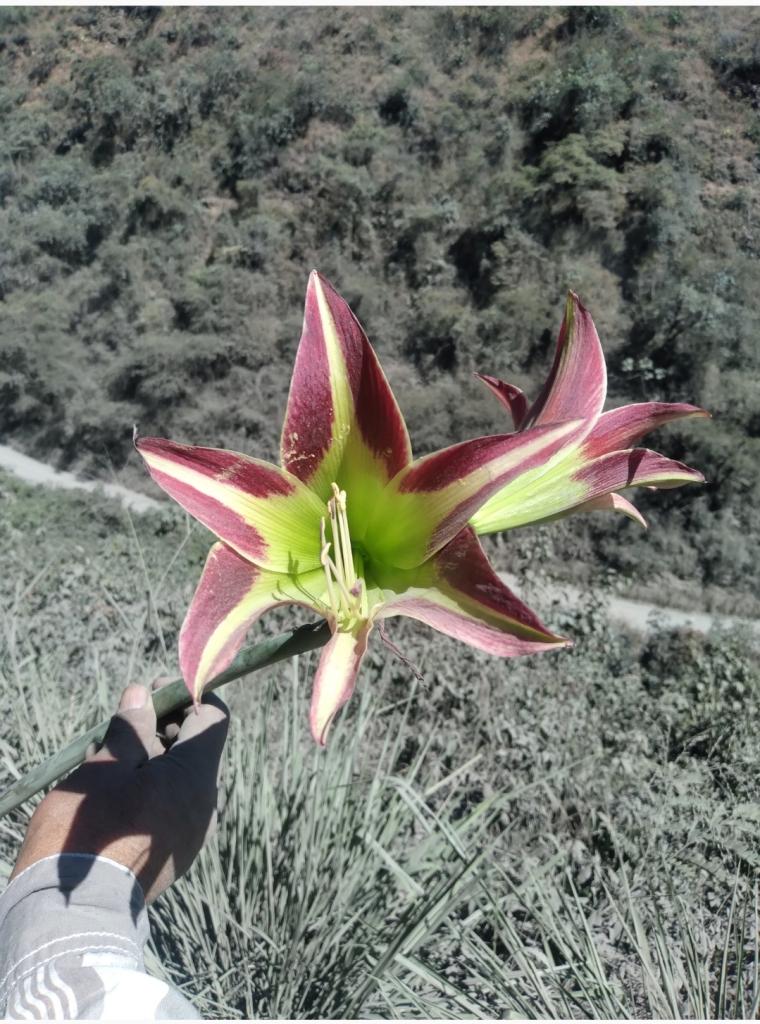Narcissus bulbocodium subsp quintanilhae, A lot was written on it by Dr. Abílio Fernandes, but I still don't understand what it is.

- Welcome to PBS Forum.
This section allows you to view all posts made by this member. Note that you can only see posts made in areas you currently have access to.
#32
Current Photographs / Re: March 2024
March 26, 2024, 12:34:05 AM
Asphodelus ayardii. I finally found a good stand only a 10 min drive and 10 min walk from home, and we got rain, so they will set good seed.
Also fistulosus and cerasiferus in the area, they don't seem to hybridize. The flowers of ayardii stay open a little longer than those of fistulosus, it was about 17:20 and all fistulosus were closed.


Also fistulosus and cerasiferus in the area, they don't seem to hybridize. The flowers of ayardii stay open a little longer than those of fistulosus, it was about 17:20 and all fistulosus were closed.
#33
Current Photographs / Re: March 2024
March 22, 2024, 12:31:13 PM
The Oncostema peruviana 'ifniensis' is already in bloom

And Moraea mediterranea

And Moraea mediterranea
#34
Current Photographs / Re: March 2024
March 19, 2024, 11:50:06 PM
More N. hedraeanthus



And a tiny endemic, Tractema (Scilla) paui





And a tiny endemic, Tractema (Scilla) paui
#35
Current Photographs / Re: March 2024
March 19, 2024, 11:44:21 PM
Hi, Robin, many thanks!
Some wild daffodils in NE Andalusia
Narcissus coronatus (= pallidulus)



Narcissus longispathus





Narcissus hedraeanthus


Some wild daffodils in NE Andalusia
Narcissus coronatus (= pallidulus)
Narcissus longispathus
Narcissus hedraeanthus
#36
Current Photographs / Re: March 2024
March 13, 2024, 02:55:35 PMHi, Uli. I don't know and I don't know (or remember). I just bought it from rareplants before Brexit, I am focused on other things. But I wouldn't be surprised if there were no substantial differences.I know very little about Albucas, but I think the brown-red bracts, greenish pendant flowers, and scabrid/hairy straight leaves are a strange combination.I wonder if anyone else took the seeds, I did not write down the reference and though I keep all 'invoices', I could not find this one.
The Narcissus was EX03_238, so I keep thinking that the Albuca is earlier.
Carlos
#37
Current Photographs / Re: March 2024
March 13, 2024, 08:14:21 AM
Albuca 'spiralis' ex Château Pérouse, from EX02 I think. It obviously is not spiralis...




And Narcissus obesus, also from CH-P, again it is not the right thing, it is the 'false Portuguese obesus'..



Oncostema peruviana 'ifniensis' preparing to bloom

And a wild Iris pseudacorus seen today. I had never taken a photo of it...

Carlos
And Narcissus obesus, also from CH-P, again it is not the right thing, it is the 'false Portuguese obesus'..
Oncostema peruviana 'ifniensis' preparing to bloom
And a wild Iris pseudacorus seen today. I had never taken a photo of it...
Carlos
#38
General Discussion / Re: Seeking source for Narcissus triandrus, "angel's tears" daffodils
March 10, 2024, 08:05:00 AM
Hi, I think that you mean Narcissus triandrus var. loiseleurii.
It is not accepted by official floras, but the plants are different from normal triandrus.
It is protected in the Habitats Directive but I obtained a permit to collect some bulbs with the help of a local amateur. My climate is not good for them, so I gave them to two friends when I had done my tests and the seeds were ripe.
I think I donated some last year.
I can ask my friends if they expect to get seeds.
Carlos
Ps. I had not read Jane's answer, I guess her solution is better.
It is not accepted by official floras, but the plants are different from normal triandrus.
It is protected in the Habitats Directive but I obtained a permit to collect some bulbs with the help of a local amateur. My climate is not good for them, so I gave them to two friends when I had done my tests and the seeds were ripe.
I think I donated some last year.
I can ask my friends if they expect to get seeds.
Carlos
Ps. I had not read Jane's answer, I guess her solution is better.
#39
Mystery Bulbs / Re: Unknown
March 10, 2024, 07:33:29 AM
Hi, I'd say Allium neapolitanum, an European species with green anthers.
#40
General Discussion / Re: Private exchanges
March 09, 2024, 05:34:43 AM
I can surely get Acis longifolia.
And very likely
Colchicum kesselringii
Fritillaria tubiformis
Iris stenophylla
There is a possibility to have some bulbs brought to the EU in early summer and have other ones carried to the US at the end of it.
Carlos
And very likely
Colchicum kesselringii
Fritillaria tubiformis
Iris stenophylla
There is a possibility to have some bulbs brought to the EU in early summer and have other ones carried to the US at the end of it.
Carlos
#41
General Discussion / Hippeastrum lara-ricoi and pampeanum
March 09, 2024, 12:39:38 AM
Hi, I was looking for the article where H. pampeanum was published and found this in the old mailing list:
Hippeastrum pampeanum, Hippeastrum lara-ricoi - informationLuca Bove (Tue, 18 Feb 2020 12:46:11 PST)
Hi all I would like to ask for more information on 2 species of Hippeastrum:
Hippeastrum lara-ricoi (Moya, Villalba & Zenteno) Hippeastrum pampeanum.
Can anyone share the official description of plants?
Regards
Luca>
<Jane McGary (Tue, 18 Feb 2020 13:28:23 PST)
Although the monograph on Hippeastrum in Bolivia that we hope to publish someday is by Raul Lara Rico, a senior botanist of that country, that species named in his honor apparently doesn't come from Bolivia, and the other Luca mentions is almost certainly from Argentina.
So, sorry, Idon't have this information.Jane McGary>
I happen to be also looking for the paper of H lara-ricoi.
The journal asks for $20 and I was about to pay, even if I hate having to pay for scientific papers as I know that the money does not go to authors, but it's not so expensive after all, but if someone wants to share the amount...
H. lara-ricoi
One page with photos from the paper is shown when you launch the name:

It is indeed a Bolivian plant, apparently very similar, if not the same, as H. yungacense and 'H. escobaruriae'.
I was thinking that it is the plant sold as yungacense by Telos, but it rather seems a hybrid (Kiara?)

What I consider 'typical' yungacense has flowers of a dull garnet red, even more zygomorphic and reminding of glaucescens that the previous two:

But one could consider that it is intraspecific variation. Both types grow in the same area.
Regarding H pampeanum, the name is misleading as they also call 'pampa' some grassy habitats in Southern Brazil. In addition to this, the name is not in IPNI, so I doubt that it has been published at all.
Telos offers this plant as well, from seed of Regis Bastian surely.
There is something going on with multi-flowered red Hippeastrum in Southern Brazil, as for a long time there was 'only' sanctae-catarinae, but suddenly the splitting fever burst up and now 'there are' laklano, multiflorum, pampeanum, ramboi and one more I forgot, I think.
Even Bastian admits that some are probably the same (I recommend the groups 'Amaryllidaceae: home for all' and 'Planet Botanical Hippeastrum' on Facebook. Even Lara Rico's posts are seen there).
A Russian living in Italy is selling all of them, grown from seed bought from Mauro Peixoto (laklano) and Bastian (the rest). I will buy one of each for my project.
Carlos
Hippeastrum pampeanum, Hippeastrum lara-ricoi - informationLuca Bove (Tue, 18 Feb 2020 12:46:11 PST)
Hi all I would like to ask for more information on 2 species of Hippeastrum:
Hippeastrum lara-ricoi (Moya, Villalba & Zenteno) Hippeastrum pampeanum.
Can anyone share the official description of plants?
Regards
Luca>
<Jane McGary (Tue, 18 Feb 2020 13:28:23 PST)
Although the monograph on Hippeastrum in Bolivia that we hope to publish someday is by Raul Lara Rico, a senior botanist of that country, that species named in his honor apparently doesn't come from Bolivia, and the other Luca mentions is almost certainly from Argentina.
So, sorry, Idon't have this information.Jane McGary>
I happen to be also looking for the paper of H lara-ricoi.
The journal asks for $20 and I was about to pay, even if I hate having to pay for scientific papers as I know that the money does not go to authors, but it's not so expensive after all, but if someone wants to share the amount...
H. lara-ricoi
One page with photos from the paper is shown when you launch the name:
It is indeed a Bolivian plant, apparently very similar, if not the same, as H. yungacense and 'H. escobaruriae'.
I was thinking that it is the plant sold as yungacense by Telos, but it rather seems a hybrid (Kiara?)
What I consider 'typical' yungacense has flowers of a dull garnet red, even more zygomorphic and reminding of glaucescens that the previous two:
But one could consider that it is intraspecific variation. Both types grow in the same area.
Regarding H pampeanum, the name is misleading as they also call 'pampa' some grassy habitats in Southern Brazil. In addition to this, the name is not in IPNI, so I doubt that it has been published at all.
Telos offers this plant as well, from seed of Regis Bastian surely.
There is something going on with multi-flowered red Hippeastrum in Southern Brazil, as for a long time there was 'only' sanctae-catarinae, but suddenly the splitting fever burst up and now 'there are' laklano, multiflorum, pampeanum, ramboi and one more I forgot, I think.
Even Bastian admits that some are probably the same (I recommend the groups 'Amaryllidaceae: home for all' and 'Planet Botanical Hippeastrum' on Facebook. Even Lara Rico's posts are seen there).
A Russian living in Italy is selling all of them, grown from seed bought from Mauro Peixoto (laklano) and Bastian (the rest). I will buy one of each for my project.
Carlos
#42
Current Photographs / Re: March 2024
March 08, 2024, 11:58:26 AM
Here goes another one with a tricky nomenclature, a favourite of mine. Sorry, long post.
Today's plant was placed peacefully in Scilla for almost two centuries (from 1800 to 1998).
Rafinesque, for me one of the greatest 'unfairly underrated splitters who were right', disgregated Scilla in many small to rather big genera, often because if presence / absence of bracts and/or bracteoles. He created
Tractema in 1837. It has bracts, but no bracteoles. But the plant remained in Scilla either as a species or lumped in S. verna until Austrian prof. Speta, another underrated visionary, resuscitated Rafinesque's genera in 1998.
Ok, but Tractema verna is an Euro-Siberian plant, and the plant shown here occurs in the Mediterranean climate, from coastal areas on the Atlantic shore on sandy soils, often in Pinus pinea clear forests, with Romulea clusiana and gaditana, etc. to inland oak forests in Cádiz and Málaga provinces at 800 m or more. This plant of mine was accidentally collected in Chiclana, Cádiz, Spain by a friend when looking for Squilla (Urginea/Drimia).

It was first called Scilla ramburei, which is wrong as it honours Rambur, so it should be ramburii.
A second, smaller species has perfumed flowers and was first called Scilla odorata, type locality the Algarve, at Lagos and Cape Sao Vicente, with Narcissus obesus and Hyacinthoides vicentina (mauretanica?), Portugal.
Problems:
The Portuguese botanist Rubim Almeida was the one to write the chapter on Scilla for Flora Iberica, the latest work on the flora of the Iberian peninsula and the Balearic islands.
He identified wrongly a population of Tractema verna as odorata and as he found no difference with true verna (evident) he synonymized odorata with verna (as verna subsp. verna).
In addition to this, he ignored the latest molecular evidence and did not accept Tractema as a distinct genus. This might not have been entirely his fault, as the editors have been consistently on the conservative side since the work was begun in the late eighties.
So well...
Carlos
Today's plant was placed peacefully in Scilla for almost two centuries (from 1800 to 1998).
Rafinesque, for me one of the greatest 'unfairly underrated splitters who were right', disgregated Scilla in many small to rather big genera, often because if presence / absence of bracts and/or bracteoles. He created
Tractema in 1837. It has bracts, but no bracteoles. But the plant remained in Scilla either as a species or lumped in S. verna until Austrian prof. Speta, another underrated visionary, resuscitated Rafinesque's genera in 1998.
Ok, but Tractema verna is an Euro-Siberian plant, and the plant shown here occurs in the Mediterranean climate, from coastal areas on the Atlantic shore on sandy soils, often in Pinus pinea clear forests, with Romulea clusiana and gaditana, etc. to inland oak forests in Cádiz and Málaga provinces at 800 m or more. This plant of mine was accidentally collected in Chiclana, Cádiz, Spain by a friend when looking for Squilla (Urginea/Drimia).
It was first called Scilla ramburei, which is wrong as it honours Rambur, so it should be ramburii.
A second, smaller species has perfumed flowers and was first called Scilla odorata, type locality the Algarve, at Lagos and Cape Sao Vicente, with Narcissus obesus and Hyacinthoides vicentina (mauretanica?), Portugal.
Problems:
The Portuguese botanist Rubim Almeida was the one to write the chapter on Scilla for Flora Iberica, the latest work on the flora of the Iberian peninsula and the Balearic islands.
He identified wrongly a population of Tractema verna as odorata and as he found no difference with true verna (evident) he synonymized odorata with verna (as verna subsp. verna).
In addition to this, he ignored the latest molecular evidence and did not accept Tractema as a distinct genus. This might not have been entirely his fault, as the editors have been consistently on the conservative side since the work was begun in the late eighties.
So well...
Carlos
#43
Current Photographs / Re: March 2024
March 04, 2024, 11:09:51 PM
The 'medium-season' strain of the quite robust, big- flowered, bulbocodium-type Narcissus with narrow and upright to arching leaves, widely distributed in Portugal, and received from Uli, has started blooming (on the right, and at the bottom). It is widely misidentified as obesus, even by Portuguese naturslists, but it is not, and one name given to it seems to be N. bulbocodium subsp. tenuifolius.


On the left, and at the top in the second photo, another robust bulbocodium from northern central Spain in euro-Siberian climate, growing along streams and in wwet meadows, with much wider and stouter leaves which are not so erect, and flowers more like 'normal bulbocodium'. A name which was undoubtedly published for it is Narcissus bulbocodium subsp. validus, but it lacked a Latin or English diagnose and it is not 'validus' (sorry for the joke). It might be Corbularia conspicua, but when one enters Corbularia territory gets immediately lost in a sea of obscure, short descriptions in Latin from late 17th century or the 18th, with phrases like "it comes from Spain, it comes from the Pyrenees". At least Salisbury included texts in "olde Englifh", which are fun to decipher.
So I still don't know which name is correct, but I will try.
Here the flowers, 'validus/conspicuus" on the right now, tenuifolius on the left.

Hoping for some rain...
Carlos
On the left, and at the top in the second photo, another robust bulbocodium from northern central Spain in euro-Siberian climate, growing along streams and in wwet meadows, with much wider and stouter leaves which are not so erect, and flowers more like 'normal bulbocodium'. A name which was undoubtedly published for it is Narcissus bulbocodium subsp. validus, but it lacked a Latin or English diagnose and it is not 'validus' (sorry for the joke). It might be Corbularia conspicua, but when one enters Corbularia territory gets immediately lost in a sea of obscure, short descriptions in Latin from late 17th century or the 18th, with phrases like "it comes from Spain, it comes from the Pyrenees". At least Salisbury included texts in "olde Englifh", which are fun to decipher.
So I still don't know which name is correct, but I will try.
Here the flowers, 'validus/conspicuus" on the right now, tenuifolius on the left.
Hoping for some rain...
Carlos
#44
General Discussion / Re: Private exchanges
February 26, 2024, 10:49:14 PM
Hi, there are fewer of us in the EU, but would it apply as well?
#45
Current Photographs / Re: February 2024
February 24, 2024, 02:39:57 PM
Mine is from him, as well, but he has two clones. First came from Antoine Hoog, he told me himself.
I think we have the same one.
I think we have the same one.
